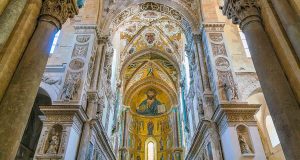The Cefalù wash house is an ancient public wash house dating back to the Middle Ages. It is one of the most symbolic monuments of this fantastic town and its history is linked to an ancient legend. In fact, it is fed by the river Cefalino, which is said to have been formed by the tears of a nymph disappointed in love.
The medieval wash house of Cefalù
The ancient medieval wash house of Cefalù is located along Via Vittorio Emanuele and is now housed in a late Renaissance building: Palazzo Martino. It can be reached by climbing a staircase made of the typical local stone called “lumachella”. This leads to a partially covered room where there are tanks that were used in the past for washing clothes. Here, through twenty-two cast-iron mouths, the water of the river Cefalino gushes out and ends its course in the sea. The wash-house was demolished in 1514 and rebuilt in a position further back from the city walls. Later, around 1600, a cover was built over the river, which had previously flowed openly.
The wash house of Cefalù and the river Cefalino
On the right side of the medieval washhouse of Cefalù there is a plaque in Latin that translates: “Here flows the Cefalino, healthier than any other river, purer than silver, colder than snow”. The name Cefalino refers to the waterway used by the wash-house and is linked to an ancient legend.
Interesting fact: Giovanni Boccaccio, in his “Book of the Mountains and Rivers of the World”, was the first to call this river Cephalino.
The legend of Dafni and Naide
In Sicilian mythology, Daphnis is the hero of the shepherds and the inventor of the bucolic song, son of the god Hermes and the nymph Daphnis. According to some versions he was born in the valley of the river Irminio, in the province of Ragusa, while according to others he was born in the mountains of Erei, in the province of Enna. He was raised by nymphs and the god Pan, who taught him the art of music and singing with the bagpipe, and when he grew up he became a shepherd. Daphnis married the nymph Naide, daughter of the goddess Hera, wife of Zeus. The shepherd’s fame as a magnificent boy and singer reached the court of King Zeno, who decided to invite him to a feast to perform for his guests. During the event, Queen Climene fell in love with the boy and made him drunk by giving him wine with laurel juice. At this point, Daphnis, no longer conscious, betrayed Naide to the queen.
The legend, Cephalinus and the rock of Cefalù
There are several versions of this legend, which differ in how the death of Daphnis is told. In some, Hera, Naide’s mother, realizes the betrayal and takes revenge by blinding Daphnis. The shepherd flees in despair through the countryside, singing all his grief until he kills himself by throwing himself off a cliff. But at that moment Hermes, Daphnis’s father, moved and transformed him into a rock, which would correspond to the rock of Cefalù. In another version, however, it is Naide who decides to punish her lover’s betrayal with death, only to regret it later. It will be her tears that will form the river Cefalino that will feed the wash-house of Cefalù.
Aggiungi ai preferiti



















